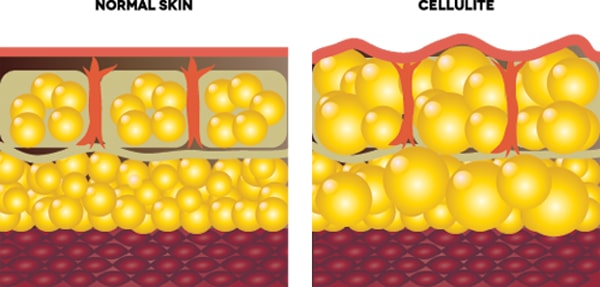Few things ruin body confidence quite like cellulite. You can struggle to shed every trace of fat and possess the perfect physique but still suffer from this harmless dimpling on your backside. Cellulite is the universal bane of the female sex across the globe, with reports suggesting that it affects up to 90% of all women but only a handful of men. Despite its prevalence, most affected individuals remain ignorant of the facts, and contribute their affliction to overeating or being overweight. However, cellulite’s relationship with fat is much more complex than simply being indicative of a few extra pounds.
What is cellulite?
Most of us are familiar with the lumpy ripples indicative of cellulite, but few understand its biological cause. Your subcutaneous layer is book-ended by your skin and various muscles, and mostly houses connective tissue and adipose tissue, which is more commonly referred to as fat. To keep your skin from sliding around, loose connective tissue called Superficial fascia anchor your flesh to your muscles in the form of various long strands. Superficial fascia only occurs sparingly across your body and are supposed to lie across your fat but below the skin. Unfortunately, fat cells tend to herniate between the connective cords because of the increasing pressure they create as they expand, which results in the unattractive dimpling that women know so well.
What is cellulite’s relationship with fat?
Since cellulite is essentially caused by fat, a natural correlation exists between the two. In other words, as the numbers on your scale go up, so do your chances of suffering from severe cellulite. However, this affliction is more related to your body’s percentage of fat rather than exact weight, which is probably why it affects almost all mature women and very few men. After puberty, estrogen forces the body to store more fat around one’s hips and thighs, giving fat more chances to poke through your connective tissue. Studies have also shown that a slow metabolism and lack of physical exercise correlate with severe cellulite, likely because these lifestyle choices also result in a higher body fat percentage.
What else causes cellulite?
Unfortunately, the number one cause of cellulite is something you have absolutely no control over – genetics. To determine your chances of developing a certain degree of cellulite you’re better off examining your mother’s thighs than your own. However, there are some other, more governable factors that are believed to contribute to the prevalence of your cellulite symptoms. Yo-yo dieting, or the constant cycle of losing and gaining weight, can worsen your symptoms because the added pressure of your fat cells against your Superficial fascia during your heavier times can cause these cells to herniate through the connective tissue. In fact, anything that causes weight gain in your thighs or hips, such as hormonal contraceptives, will worsen your symptoms. Additionally, it’s been suggested that excessively tight clothing like super skinny jeans might have a similar effect, since they also add pressure, even though it’s externally forced.
Does Exercise Help Cellulite?
According to Dr. Lisa Donofrio, M.D., assistant professor of dermatology at Yale University, exercise can improve the appearance of cellulite, but aerobic exercise alone won’t do it. To get the benefits, she emphasizes that you need to do resistance workouts to build muscle – not just aerobics. Adding additional muscle helps the skin lay more smoothly over the muscle, which reduces dimpling. At the same time, exercise reduces body fat, which means there’s less subcutaneous fat to poke through.
Keep in mind that exercise isn’t a “cure” for cellulite, but it may improve its appearance. If you develop some degree of musculature in your butt and thighs, any existing cellulite is going to be less noticeable. In addition, the less body fat you carry in those areas, the less visible cellulite there will be, so weight loss helps as well.
Unfortunately, too many people are looking for quick solutions to cellulite. They’d rather rub cream on their thighs than do squats and lunges. The simple reality is that no cream or lotion currently available significantly reduces cellulite, although there are treatments that hold some promise. These include systems that use infrared light, radiofrequency waves and negative tissue massage. Unfortunately, these are expensive therapies with results that aren’t necessarily permanent.
Cellulite and Exercise: The Bottom Line?
Exercise that includes strength-training combined with weight loss is currently the best option for keeping cellulite at bay. Before investing in creams and lotions that claim to melt away cellulite, get out the weights, and start doing something good for your butt and thighs. Don’t waste your money on quick fixes for cellulite
While there are numerous treatments that claim to diminish the appearance of cellulite, there’s still no cure that can smooth out your dimples permanently. Even weight loss isn’t guaranteed to eliminate your unattractive bumps, let alone lessen their severity. To avoid getting scammed, always research any procedures or diet plans before you make a financial commitment.
Related Articles By Cathe:
Can Foam Rolling Improve the Appearance of Cellulite?


